I hate to dampen my general wine know-it-all credibility, but the last time I was in France, the Euro was just an exchange unit. The Franc was still the currency of notes and coins. My joy for and impression of the French was greatly increased upon receiving my first 50 franc note. What a country, the Little Prince right there in my hand. For whatever reason, my country would never embrace Max on the 50, and I feel we suffer a bit for this. A culture that embraces the importance of its artistic contributions right along with the political is a grand and confident culture indeed.
This image did its job, and I tracked down a different book by Antoine de Saint-Exupéry at an English language book store and learned why France would hold this author in such high regard. I was forever changed by a quote I found in that book. A quote that I would suspect came from Japan or Sweden, but in fact was French. “Il semble que la perfection soit atteinte non quand il n'y a plus rien à ajouter, mais quand il n'y a plus rien à retrancher.” Translated in the book I read as “Perfection is achieved, not when there is nothing more to add, but when there is nothing left to take away.” This hit home with my own fledgling design esthetic and is still with me now when I consider making white wine.
I get a lot of surprised looks and disagreement when I tell people during conversation that I feel making white wine is much harder then red wine. I don’t mean physically harder, as minus the punch downs, whites are quite a bit less taxing on the body. But as for making decisions that must be correct, whites are much more demanding. I’m not the type of winemaker who will go on and on about how my immense cellar skills will take terrible fruit and craft perfect wines. I am of the firm belief that the ceiling for the quality of a wine is set the second you pick it. My experience is that my chief responsibility as winemaker is to not allow the wine to weaken in my hands once I have taken on stewardship from Mother Nature.
With red wines, you can get away with not perfectly timing your pick. You can adjust the length of cold soak and fermentation based on the ripeness level of skins, seeds and stems. You can hit your wine over the head with oak to fill holes in the nose or palate. You can just let the fruit hang for a long time in the vineyard and call it your “big, heavy, ripe style” and no one bats an eye. Whites are not so. White wines are like an ink on paper painting or calligraphy, if your lines are not skilled and beautiful, there’s no distracting with pretty colors to hide this fact. Any mistake made in the vineyard or cellar is plain to see, smell and taste. White wines, and roses for that matter, are a stripping away of everything that is possibly superfluous, leaving only the purest form of the wine behind.
Because of this I take immense pride in our white wines here at Calcareous. In particular, I stress over our white Rhone blend more than any other wine. After years of trying various varietals, I have narrowed the blend down to a yearly mix of Viognier and Marsanne. The Viognier sees no oak, as it is settled, fermented and aged in stainless for its life in the cellar. The Marsanne sees a single new French oak barrel, the balance being fermented in barrels used at least two times before filling with Marsanne. The two components are kept separate until a blending takes place a month before bottling.
This month we released our 2009 Viognier-Marsanne blend, and I could not be prouder of the wine. It took home Double Gold at the San Francisco International, then popped up last week on Steve Heimoff’s top ten of the week posting (the second straight vintage of our flagship white that Mr. Heimoff has so blessed). I also could not be prouder of Paso Robles in general. The creation of more serious white wines coming from the area is as bold a declaration of vineyard and cellar quality as any other critique. In last month’s Wine Spectator article on exciting new California Whites, Paso Robles was probably the single region getting the most acclaim. Local white wine champions like Caliza, Denner, Tablas Creek, Terry Hoage and Villa Creek were all rightly given their due for showing we here in Paso Robles have more up our sleeve than just powerhouse reds. So enjoy the summer months with these fine examples of our craft in its purest form.

The vineyards this morning produced a most philosophical perspective in me. Sunrise amongst the greenery and expansive views sometimes bring forth thoughts beyond worries of heat stress and micro-nutrient uptake. My thoughts were constantly returning to what is this essence of wine that fascinates? Why don’t people spend weekends traveling the back roads of Forest Grove Oregon and why are fortunes not made and lost based on scores from the Rutabaga Advocate? Is the wine grape a most noble crop that resides in a special world of agriculture above all others? Not that I have seen or experienced. A product lovingly raised is always unique and cherished. How then do we explain the belief that wine is portal through which deeper knowledge comes? Countless Movies, books, and blogs have all been dedicated to idea that wine produces a unique signature of place, the terroir. But does a grape vine speak more to the terroir than an heirloom tomato or pasture raised beef? In this summer season of plenty, with the mantras of slow food and flavors of locality preached on each menu, you would be mad to suggest so. Any random combination of those offerings explains Paso Robles on the palate just as much as a wine can. So again I ask myself, why the captivation with this drink?
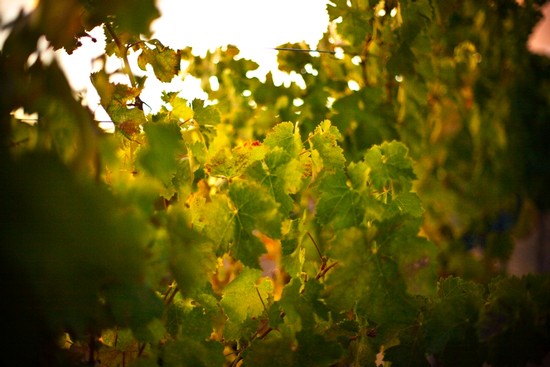
The answer to these type of questions often lie in that time which formed my perspective, my youth. Maybe it’s the answer to the riddle the Jims (Henson and Croce) asked of me in childhood. I remember the strange anxiety that small skit created in me and my initial dawning of thought on the enigmatic complexity of life, time and space. This great mystery of the unflinching progression of things was always with me in quiet times. In order to remain calm, I convinced myself that there must be a path of grace (with apologies to Terrence Malick) that could lead one away from fear and into understanding. Just because something is beyond comprehension does not mean one should recoil from it; the unknowable should be embraced. The wine we produce then is a product of that acceptance. The vintage is, in its essence, the capturing of the moment into some tangible state.
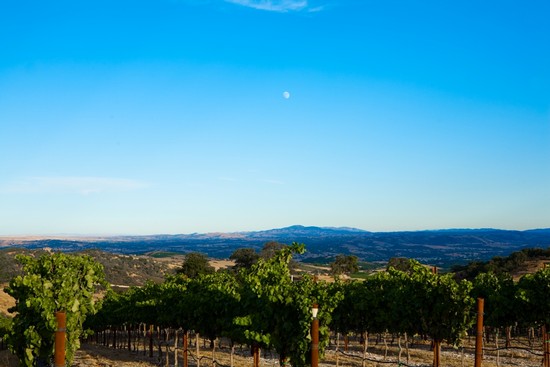
There is something more to wine than mere ethanolic intoxication. The corked bottle represents a chance to return to a place and time, without trepidation that the past is lost forever. Wine with its intrinsic link between our senses and memory can provide a wonderful window unto personal contemplation and revelation.
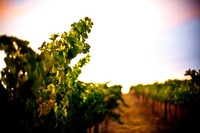
The idea of wine and the memory of my favorite wine experience are forever linked. This occurred on the island of Samos in the Aegean Sea. My future wife and I were enjoying a beach-front campground with a single little market from which to order our dinner. We sat eating a meal of fresh grilled octopus that neither of us would have ordered in different setting. Drinking a local wine, Samos Vin Doux (a fortified muscat!), that we picked off the shelf because it was the only bottle offered. Yet this perfect combination of all things new and beautiful along with the sun resting into the sea, created for us an experience that nothing could ever top. While not by any means the most technically superior wine I have ever had, it is perhaps the best wine I will ever drink.
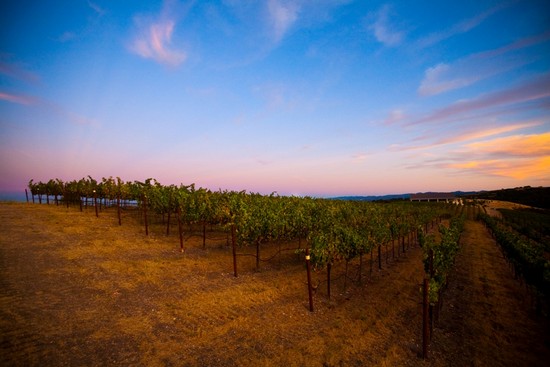
So maybe this isn’t madness, laboring as we do to create wine. As the spectre of harvest looms just weeks away and I prepare to be enveloped completely by its demands, these thoughts give me assurance that it is all worth it. That the sacrifices that must be made of time, energy, mind and family will be rewarded. The goal is sitting out there plain to see in my mind. For me it is the end of November, with fermentations few and a Thanksgiving table filled with family, friends, food, and of course, wine.
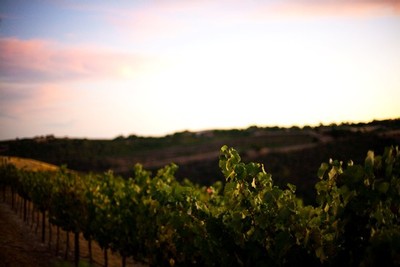
Another milestone passed in the vineyard. This one is pretty exciting, fruit set. The flowers do their magic and become what will become the grapes. We finally can see what kind of harvest we will have yield wise. And as usual, it’s all across the board. Some things have just a hint of clusters; some things are just overflowing with grape potential. Take the Malbec here for example.
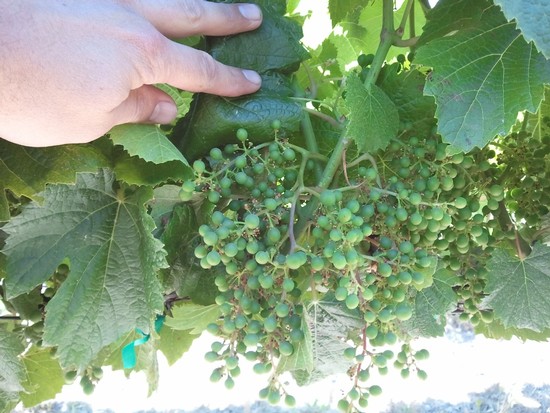
Egads, that's a lot of fruit! The Malbec is the one crop on the vineyard that every year produces a huge yield. It makes a certain amount of sense. If you look at the topography of the vineyard, the Malbec is the only block that is completely flat. Thus, the soil is deeper than everywhere else. In all the other blocks, the steep hillsides are no place for sediment to gather, so you basically have exposed limestone, or just a super thin skin of top soil. The flat spot where the Malbec is planted is at the base of the hill that the Cab Franc and Mourvedre are planted. Thus you get a richer top soil, healthier happy plants, and bigger crops. So a large portion of these clusters will have to be sacrificed for the greater good.
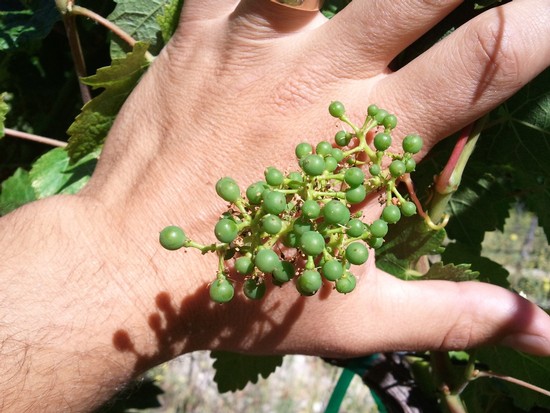
As an example, look at this tiny cluster of Cabernet Sauvignon. This is from Block 7 which is quickly becoming known as the Lloyd block. It is used each year as the basis for our estate Cab based blend called the Lloyd. From now on we will have two wines named for our founder, Lloyd Messer, the Cab based Lloyd and the Syrah based Moose. Cabernet Sauvignon in general produces smaller clusters with small berries. This is what leads to Cab being such a big wine. Just like how Petit Verdot and Petite Sirah sound French and delicate, but when you drink them, you feel the power of small berries. Block 7 in particular is very stressed and the yields are always tiny from it. Tiny clusters with only a few berries forces the plant to put everything it has into the least amount of fruit. Thus it produces an extremely concentrated and heavy wine. Look out for the 2008 Lloyd, our first wine produced from Block 7, it is a SERIOUS wine.

This time of year, with the visible signs of the vintage making themselves plain as day on the vines, you hear the same question over and over. "So how are your vines coming along, you behind?" This is one of those questions that, (yeah I know, it's just a conversation starter really), I never really know how to answer. Much like when I'm asked by tasters, "What's YOUR favorite wine of all these?” Maybe it's just my science background, but the rules of physics prevent me from answering. How does one come to a static conclusion dealing with such dynamic qualities? My favorite wine is the one that tastes the best. The problem exists that what tastes best is dependent upon parameters outside of the winemaker's or even the wine itself’s control. Not to get too 60's here, but wine is in the class of things that are completely influenced by set and setting.
This all applies to the timing of the vintage. On one hand you have an entire line of thought on the importance of vintage and how the yearly variance of wine corresponds with the unique environmental elements that produced it. Then you have the question of late or early, as if vintage was something to be avoided. I think there is the constant disconnect between the agrarian ideal that attracts people to wine, and the agrarian reality that one must comprehend to make wine. There are no concrete forms when it comes to farming, only chalky outlines meant to be blurred or redrawn on the fly. In all honesty, I think Gandalf the Grey said it best. I'll spare you my divulgence into the history of Wizards as propagated by the Druidic cultures of Northen Europe and their ritualistic role in the ensuring of successful harvests. But an important note to take from that little clip is that definitive bold proclamations made about wine should always be followed by laughter. Anyone who produces an air of stern seriousness when discussing wine is a fool.
Sure this does not really apply to large wine factories that impose modern economic models of supply and demand upon our cherished little beverage. In that world, early and late begin to exist in some context that needs to be obeyed. But the goal of Calcareous, the reason for our existence actually, is an attempt to escape that context. To exist and create in a space where the only concerns are quality, honesty, and inviting others to share our wine and escape as well. So don't fret about early or late harvests in 2011, just know that the 2011 vintage will exist. And it will be exactly as good as it is meant to be.
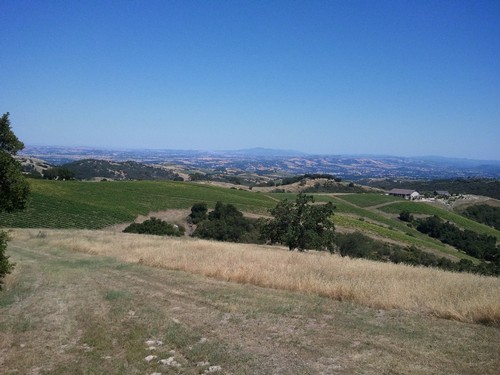
Oh my, summer has finally decided to show up. After all the craziness, like rain the first week of June, it now feels like Paso. After the cool wet winter and spring, the horrendous frosts, all the what nots and who's fors in the vineyard, things are right where they should be. June 21st and the fruit is set on everything but a couple sections of Mourvedre and Cab. The heat that is hitting right now is like flipping the turbo on; the vines seem to be just exploding. It's exciting to see and the daily morning walks in the vineyard have begun.
I firmly believe that the winemaker needs to spend as much time actually in the vineyard as possible. That to me is the whole purpose of having the vineyard and the winery on the same property. So, from this day forth, my assistant winemaker and I (and Abbie and Salty) will spend the first part of every day walking the rows. Seeing the daily changes is the only way to really put oneself on the same time cycle as the plants. Yeah, you can sit in an office and start reading number off of various probes and data collected by others. But that doesn't let you understand the vintage. To feel the dew, fog, sun, soil and wind the same way the plants do. This is where the understanding comes from. This is where the plan comes from. This is where the great wine comes from.
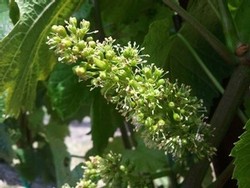
I told you I would get some photos once the grape flower showed itself. Like I said, not anything that Akira Kurosawa would have made into short film. But beautiful none the less to grape farmers and wine makers alike. Crazy to think that it is June 1st, and the Chardonnay is just flowering. Looks like Thanksgiving day for the Cab and Mourvedre in 2011. A long, long harvest awaits. But if it is anything like the long harvest quality of 2010, I'll take it.
The vineyard is safely into vegetative growth mode and it's time for our next crop control measure. This time, all those excess buds that escaped pruning day need to get taken care of. Although the pruned vine looks all clean trim, a couple weeks of shoot growth tells a different story.
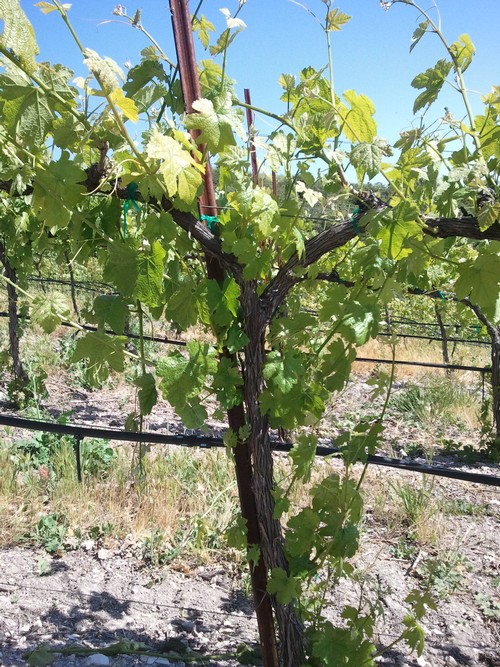
And the whole vineyard looks like that. Luckily when the shoots are young and fragile, they are easy to just knock off. So a haircut is quick and painless and you are left with a beautiful little Syrah vine all ready to start making grapes.
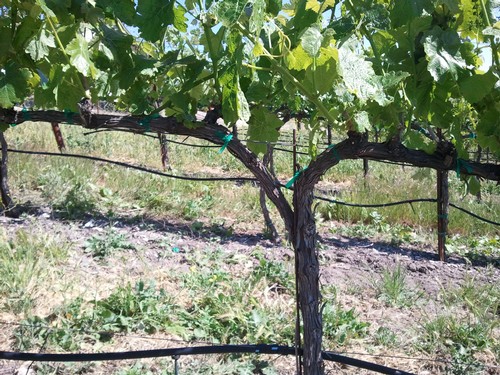
One interesting thing you notice this time of year is the proof you are dealing with a clone grafted onto a root stock and not just a wild vine. The root stock puts out shoots as well. You will see these shoots coming up from the ground that are a completely different species than the Syrah you are hoping to harvest. First, here is a nice close up of a shoot that grew from the cordon, in this case Estrella Clone Syrah.
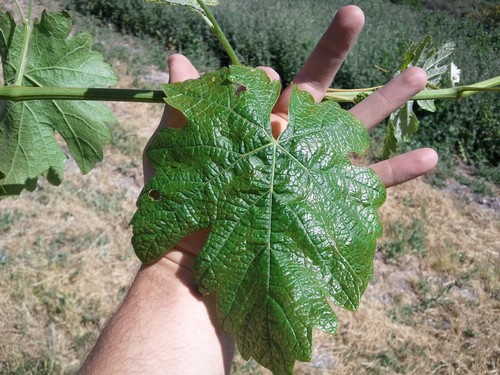
Classic Syrah leaf there, about the size of a typical human paw. Now take a look at what comes creeping out of the 1103 Paulsen rootstock.

For one, the leaf is totally different in shape. But to me, the most drastic difference is the red color of the shoot itself. The first time I walked through a vineyard, I had no idea about the whole rootstock and scion thing going on. So I was a bit shocked at this red chard looking thing bursting out of the vine. This time of year always reminds me of that first vineyard experience, and I hope to never lose that excitement about discovering new things about wine.
As a final little treat, here is the first look at the 2011 crop. Yes, the Syrah inflorescence.
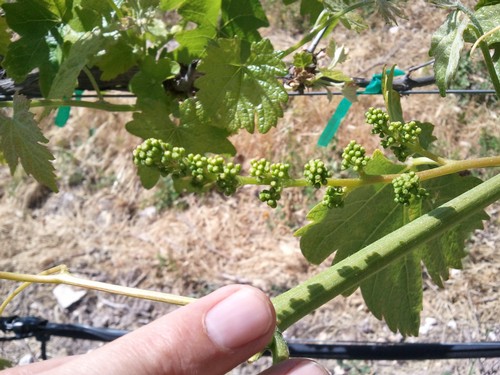
In a week or two, these little guys will pop open and reveal the beautiful grape flower. Once pollinated, these become the grapes. Sure, it's no peach orchard or anything, but it's what the grape farmer gets, and we like it. I'll take a picture of it when it happens, and we can all enjoy the splendor of flowering.
About 5 years ago, I was living on Capp and 21st in the Mission District of San Francisco. Ah the days of living post collegiate hipster lifestyle non-sense. Vegan burritos at Papalote. Buying the new Six Organs of Admittance record at Aquarious. Tweaking my Italian single speed commuter with help from Freewheel. And of course, getting a freshly pressed cup from Ritual Roasters. It was the closest coffee to my house, so an easy stumble after your typical late night. But, as much as I loved my press pot coffee from Ritual, there were days when a ride over to Philz for a hand poured cup was more the flavor I was looking for.
Today as a wine maker in Paso Robles this all came flooding back to me as I was tasting through the 2010 wines for the first time. The difference in flavors from the exact same fruit that was produced by punching down or by pumping over during harvest was amazing. So I decided to do a little experiment that might explain these wine making styles in a way a bit more familiar to most people. Friday morning was 2009 Zinfandel blending trial day. Spending the morning tasting multiple samples of Paso Robles Zin can lead to nap time real fast. So to wake everyone back up, coffee was called for.
The winery lab became a coffee brewing lab for the day. I wanted to see if making coffee with a press pot and a pour over would produce similar differences as do punch-down wines and pump-over wines. Plus I'd throw in a baseline cup made from Costco's finest just to make things a bit more fun and prove that care and good decisions in the vineyard and winery really do matter.
First the the baseline cup, which would be the "factory" wine style. Machine harvested, huge fermenters, all about high through put and low price. These are your $10 and lower bottles, or your gas station coffees. Auto-drip of course, because hand punching down 500 tons of fruit can be a bit tough. It will be represented by a 2 month old can of pre-ground dark roasted Costco pure Columbian "Supremo" (must be Spanish for really good eh?) I raided from the winery kitchen. Juan Valdez on there speaks to the authenticity.
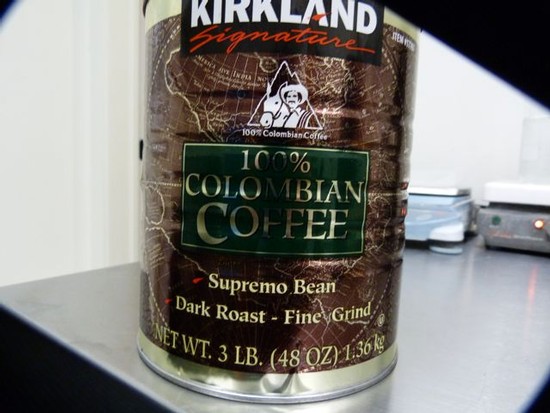
This will then be brewed in a classic Black and Decker auto-drip brewer. Because when you think of culinary excellence, you think of Black and Decker right?

The contenders will be a Bodum press pot, which will represent the punch down method of winemaking.

And in the other corner, a Chemex pour-over, because pour-over and pump-over are almost the same thing. At least when you say them.
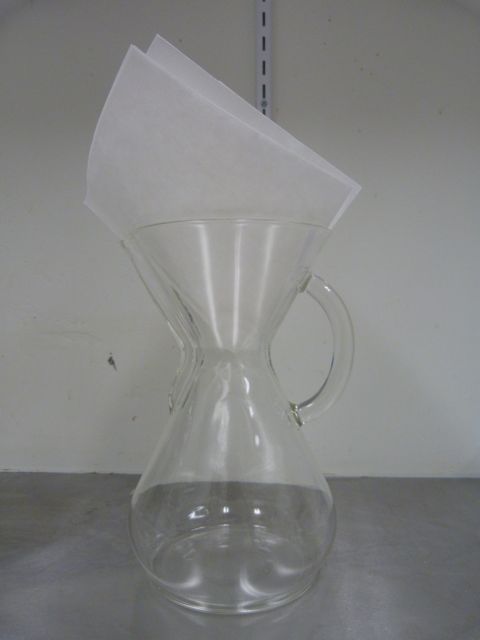
For our more barista approved brewing methods, we'll be using a Guatemalan coffee from Four Barrel in San Francisco. Purveryours of fine fresh roasts and also where I scored the Chemex for a super deal!

As you can see, this is a much lighter roast than the Costco stuff. First a close up of the DARK roasted supremo.
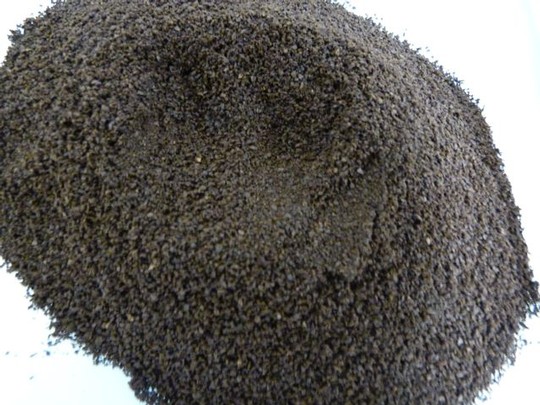
Oh my! Now the lighter roast more "fruit-forward" coffee.

To keep things scientific, we will use 800 ml of water to go along with that 53.39 grams of coffee for each of the three methods. The Black and Decker will heat water by itself, to an impressive 154 F. Since my hopes for the baseline cup are next to nil, the pure science will leave that brew behind. The other two methods will get heated up to the recommended 197 F. Of course using a hot plate and stir bar for even accurate heating.

So rough grind, into the press-pot and in goes the water. A quick stir and 4 minutes later, the press.

Our "pump-over" coffee gets a slightly finer grind and a once over with the water.

Time for the results. Here are the three brews properly displayed in Pyrex beakers for that lab look and feel. The dark roasted Columbian is the darkest as you would expect. But what is amazing is the color difference in the press-pot in the middle and the pour-over on the right.

I was impressed by how this pretty much confirms the convention in winemaking. The use of punch downs is considered a much more gentle treatment of the fruit. Pumping the must over the top of the skins is more extractive. You will get deeper color and more tannins that way. Which sounds great, but sometimes these can overpower the fruit. Thus punch downs are preffered when your are looking to emphasize complexity and nuance as opposed to power. As far as the coffee goes, it was amazing how harsh and bitter the Costco cup was. It required some cream and sugar to choke down. Another great analogy to wine as under-ripe and over-extracted wines are often left with a bit of residual sugar because it hides the bitterness. Whereas properly ripened fruit, like properly roasted coffee, produces all the wonderful full flavor with none of the harsh bitterness. I encourage you to try this at home. It is great practice in sensing bitter in what you drink. And also you will also teach your palette how sweetness hides the harsh flavors so you can call out wines that use that crutch.
To conclude, I wouldn't say always punch-down or always pump-over your wine. They don't live in a better or worse type of world. They produce different end products, and it is up to the wine maker to make the correct decision as to when to use the technique that will get the most out of the grapes, or in this case, the beans.
One of the challenges of working with a newly producing vineyard is that is takes you quite a few vintages to figure out your barrel program. Winemakers will all have favorite barrels that are kind of their go to options, but until you get to really know the fruit the vineyard is producing, it's mainly guess work. Different barrels will add different features to the overall experience of the wine. Suffice to say, some barrels you smell and taste in the wine. Other barrels you only feel. And only developing that first hand knowledge of what the fruit from a vineyard needs will allow you to have a successful barrel program.
To begin this post in another way, experimentation with barrels is still the name of the game here at Calcareous. A barrel that I brought in for the first time in 2010 was Keystone Cooperage. I had asked around few other winemakers in Paso and gotten positive feedback about Keystone. Solid barrel for Cabs, Syrahs, and Zins was the general consensus. That can be a bit scary though because those are the big boy wines and are capable of hiding barrel character. I often talk about how early American coopers made oak barrels for things like salt pork and whiskey. Nobody cares if there's a bit of woody flavor in those things. I mean, throw down a shot of Old Potrero and impress the crowd by saying "Oh that's really smooth but the oak finish really overpowers there." Um, probably not going to happen. You need all the smoke and wood possible to stand up to the huge flavors in whiskey, so the barrels can be monsters. Thus American barrels had a bad reputation because Chardonnay can, at times, be a bit more restrained then rye. Luckily things have changed.
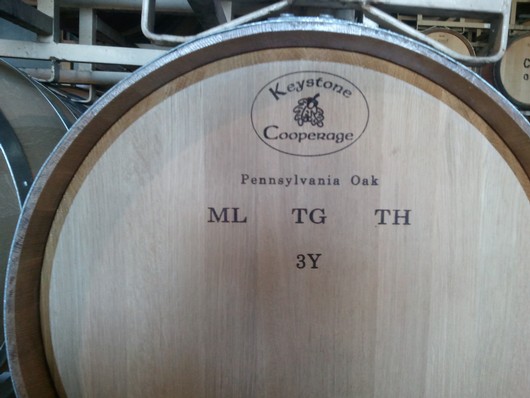
To prove the point, let's decipher all the letters and numbers on that barrel head. First the cooperage stamp is rather self explanatory. Nice little oak leaf and acorn design there I must say. Next, most American barrels will now tell you where trees were grown. The climate that the forrest grows in determines the grain structure of the wood. Warm regions produce faster growth and wider grain. Cold forests have shorter growing seasons thus tighter grain. And when it come to American White Oak, there is a big range of where it grows.

From East Texas to Maine the great Quercus alba forest covers nearly a third of the country. Keystone is Pennsylvania only, thus you generally get medium to tight grain wood in their barrels. That is what the "TG" stands for, "tight grain". Not to produce a full tome on oak here, but generally the tighter the grain, the slower the extraction from the barrel will be.
The letters "ML" indicate the toasting level. In this case "ML" means "medium long". I requested this toasting style which is a lower heat for a longer time. A medium toast will give you more oak structure instead of the smoke and caramel you get from the toasting process. Again, that is a decision you need to make based on what you feel the wine from your vineyard needs. Also, when working with a barrel for the first time, I like to try and taste the wood not the toast. The toast can be fined tuned, the wood is the wood. The longer time of the toast gives you a deeper penetration into the wood. Thus if the wine is in the barrel for 18 months, the toast is deep enough to prevent the wine from interacting with un-toasted wood. The "TH" is another toasting indicator, meaning "toasted heads" The heads account for a significant amount of the surface area of the barrel, thus toasting the head as well is an important step if you want to control the impact of the barrel.
Lastly is "3Y" which means "three years" of wood aging. Once the trees get turned into stave logs at the mill, they sit outside. Two years is the basic time your average cooperage will allow the wood to age outside. The longer the wood is exposed to the sun, wind and rain, the milder the "oakiness" becomes. This is one of those "aha" things the French had to explain about how to make barrels for wine instead of whaling ship rum. Thus, with American oak that can be a bit more powerful than French oak, I prefer a full 3 years of weathering. It costs a bit more, because the stave mill needs to have the oak sitting around for an extra year before selling it, but for me it is worth it.
The last thing about these barrels that you can't see here is that they are a slightly larger size. I order these barrels in the 265 liter size. The normal French barrel size is between 225/228 liters depending on the shape. By having a larger barrel, you decrease the surface area to volume ratio, thus producing a situation with less extraction.
This month, finishing my initial tasting trials for these barrels, I have been pleased. I think Keystone will be with us for a while. If you stop by the winery, look me up and you can taste for yourself.
In the fall, the leaves on the vines turn their beautiful colors and eventually fall off. The vines themselves enter a dormant state, mirroring the farmers and vintners who need a long winter's nap to recover from harvest.
Eventually spring rears its wonderful head bringing warmth and sunshine to wake everything up again. The buds on the pruned vines begin to break open and the great cycle of the vintage begins. This week at the end of March marks that beginning for the 2011 vintage.
Now either in tasting notes you have read, or at some winemaker's speech you have survived, you may have heard that not all grapes ripen at the same time. Here at Calcareous, some grapes we pick at the end of August and some we pick in the middle of November. And contrary to what some might say, that waiting until November is not some ploy to get the fruit "over ripe" to make big jammy Paso wine. No, the fact is, each variety planted here marches to its own beat when determining the timing of when its fruit will be ready. Some vines take their own sweet time, and no other time of year shows this as clearly as bud break.
Every year, the first grape picked off the Calcareous vineyard is the Chardonnay. Here is what that Chardy looks like today.

Hope and life spring eternal, literally! An exclamation because you don't get to be literal all that much in life these days. Now of course, the constant worry of a freeze that could damage these fragile buds is ever present. Well, not actually. Here is a tip to any of you out there that are looking to plant a vineyard for your future award winning estate winery. Plant on a steep hill. Oh sure, it makes working the vineyard feel like a constant mountain hike, you need crawler tractors, and irrigation and ripening are irregular. But the big plus, we have never had a frost problem here*. So these buds will soon be leaves, stems, and flowers.
Now, why don't we walk 75 yards due east and see what is happening with the Mourvedre.
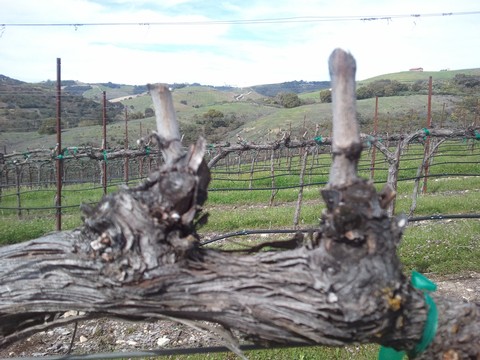
Um, not much. Mourvedre is always in a race with the Lloyd Block Cab Sauv to see who gets picked last. And as you can see here, budding is still a couple weeks away. Not a hint of green anywhere in the whole block. The Mourvedre vines are weeks behind the Chardonnay in general life cycle. Thus, the fruit will ripen weeks later. Sure this is a bit of a simplification of things, but it is always interesting to me see the order of bud break as it outlines my general planning of harvest.
You can start to put together a flow chart in your mind of what fruit will go into what fermenters. There are dreams about various co-ferments from fruit that ripens at the same time. Last year, the top of a section of Syrah and the bottom of the Merlot broke the same week. So I thought, why not, during harvest a small 1 ton co-ferment of the two. If you ever visit in the next year, you can taste that experiment and see what you think. I for one am in love as these two maligned beauties work wonders together. Things like that won't happen every year, so by paying attention to the vineyard now, you can prepare for the little bits of magic as they may occur.
Finally, an aside for those who read my post on pruning. I mentioned that the ideal goal is to get two buds from each spur position. This way you get the low yields and concentrated fruit you hope for. I also mentioned that this two bud thing is a dream. Sometimes, like in the above Chardonnay photo, you get a perfect two buds and all is well. Sadly, a lot of the time things look like this Malbec here.
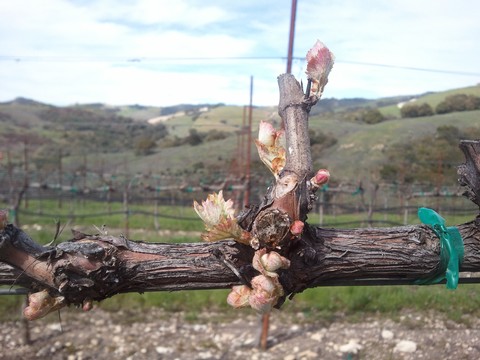
A solid 8 buds there, and that is only the one side. This means that we will have to go back through in the next month, and pull off all the extra shoots. So for those keeping count, this will be the second time this year each vine will be visited and adjusted by hand. There will be many more of these visits over the next 6-7 months. Hopefully I'll write a little post about each of them.
*Please Snow Miser, I am not challenging you. Please stay down in your cold, yet comfortable low lying areas.